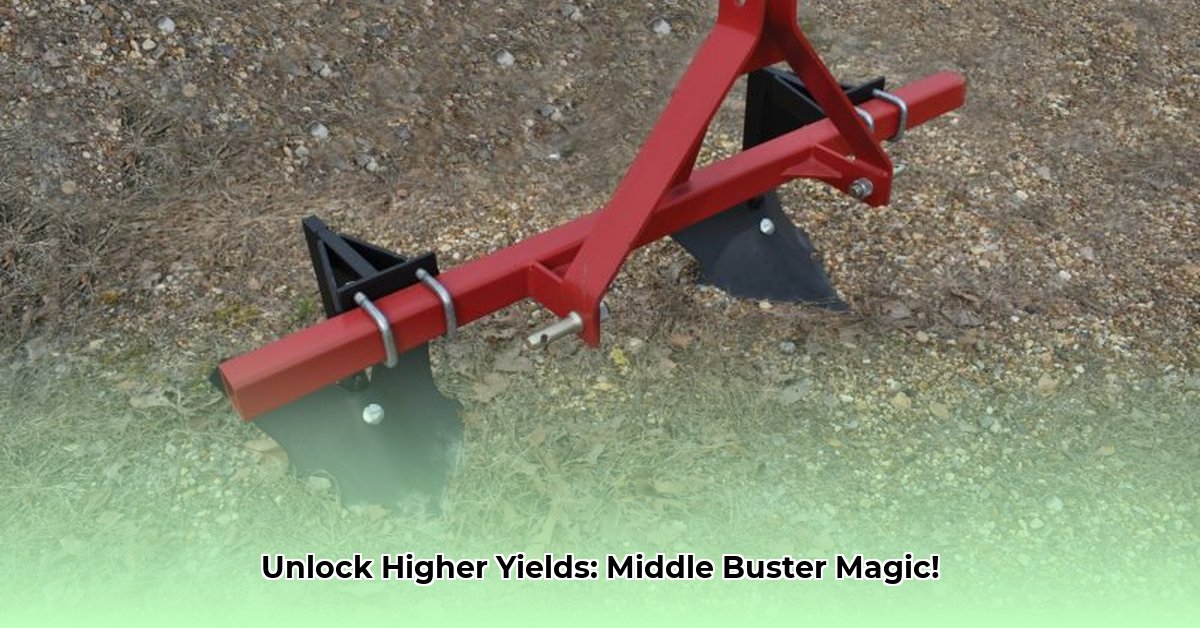
Tired of backbreaking labor harvesting root vegetables? A 3-point middle buster, attached to your tractor, can revolutionize your farming operation, significantly boosting yields while reducing manual effort. This comprehensive guide will equip you with the knowledge to effectively utilize this tool, from understanding its mechanics to optimizing its use for maximum efficiency. Learn more about tractor PTO systems at this helpful resource.
Understanding the 3-Point Middle Buster
A 3-point middle buster is a tillage implement designed to create furrows for planting and harvesting root crops. Unlike a plow that inverts the soil, it creates a narrow trench, minimizing soil disturbance while preparing a perfect seedbed or harvest path. This is ideal for crops like potatoes, carrots, and beets.
How a Tractor Middle Buster Works
The middle buster's operation is relatively straightforward. A sharp, pointed blade (the share) cuts into the soil, while a curved moldboard moves the soil to each side, forming the furrow. Depth adjustment allows you to adapt to varying soil conditions and crop sizes – deeper furrows for larger potatoes, for example.
Here's a step-by-step instructional guide:
- Hitching: Securely attach the middle buster to your tractor's 3-point hitch, ensuring a tight and stable connection.
- Depth Setting: Adjust the depth according to your soil type and crop requirements. Deeper furrows generally benefit larger root crops.
- PTO Engagement: Engage your tractor's power take-off (PTO) to power the middle buster.
- Speed Control: Maintain a steady, moderate speed. Excessive speed risks equipment damage, while overly slow operation reduces efficiency.
- Monitoring: Continuously monitor furrow creation and adjust depth or speed as needed for optimal results.
Weighing the Pros and Cons
While the middle buster offers considerable advantages, it's crucial to acknowledge its limitations.
| Advantages | Disadvantages |
|---|---|
| Significantly reduces manual labor | Effectiveness dependent on soil type |
| Ideal for planting and harvesting root vegetables | Requires a tractor and appropriate 3-point hitch attachment |
| Minimizes soil disturbance | Potential for soil compaction if not operated carefully |
| Relatively easy to operate | Safety precautions paramount |
Choosing the Right Middle Buster
Selecting the appropriate middle buster requires careful consideration of several factors:
- Tractor Power: Ensure your tractor possesses sufficient power for the intended tasks.
- Soil Type: Rocky or clay soils might require a heavier-duty model compared to sandy soils.
- Crop Size: Furrow dimensions should match the size of your root vegetables.
- Budget: Middle busters are available across a diverse price range.
Safety First: Essential Precautions
Safety is paramount when operating any farm equipment. Always adhere to the manufacturer's instructions and safety guidelines. Obtain proper training before operation and never operate the equipment unless fully comfortable and understanding its functions.
"Always prioritize safety when using farm machinery," advises Dr. Emily Carter, Agricultural Engineering Professor at the University of California, Davis. "Proper training and adherence to safety protocols are essential for preventing accidents and injuries."
Comparing Middle Buster Efficiency to Other Methods
How does a 3-point middle buster compare to other potato harvesting methods? Let's explore some alternatives:
Specialized Potato Harvesters: Highly efficient for large-scale operations, these machines combine digging, separating, and cleaning. However, the substantial upfront investment limits their suitability for smaller farms.
Manual Harvesting: A labor-intensive method, suitable only for very small operations.
Combination Methods: Employing a middle buster for initial loosening followed by manual harvesting balances cost and efficiency.
Key Considerations for Efficiency Comparison:
- Soil Conditions: The middle buster excels in loose, well-drained soil but struggles with heavy clay or rocky conditions.
- Field Size: Ideal for smaller fields, its efficiency diminishes with increasing scale.
- Labor Costs: Compared to manual harvesting, the middle buster often proves more cost-effective in the long run.
- Yield and Quality: While potentially yielding slightly less than specialized harvesters, the middle buster often provides acceptable results.
Is a Middle Buster Right for You?
The suitability of a middle buster depends on your farm's size, soil type, crops, and budget. Weigh the long-term benefits against potential challenges. Many farmers find the increase in yield and labor savings justify the investment. The ultimate decision hinges on your unique circumstances. Consider conducting a cost-benefit analysis – including factors like purchase price, maintenance, fuel costs, and labor savings – to make a well-informed decision.